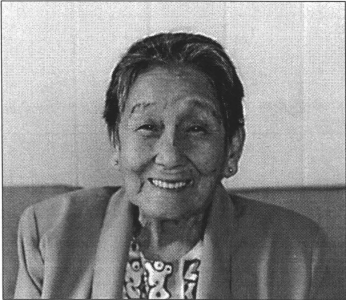Kimiko Kuwana Sakai

Tsunamis Remembered: Oral Histories of Survivors and Observers in Hawai‘i
Life history interviews with individuals who witnessed and survived tsunamis-particularly the 1946 and 1960 disasters on the Big Island of Hawai'i. Thirty individuals-mostly residents of Hilo and Laupahoehoe-recall their experiences before; during, and after the 1946 and 1960 tsunamis which were arguably the most destructive natural disasters in modem Hawaiian history.
Kimiko Kuwana Sakai, daughter of Japanese immigrants, Hisa Muranaka Kuwana and Jitsuzo Kuwana, was born on April 26, 1916, in Pahoa, Hawai'i. She is one of eight children born to the Kuwanas. Her mother's main responsibility was running the household and caring for the children. Her father was a foreman at 'Ola'a Sugar Company plantation. Sakai graduated from Hilo High School in 1934 after completing Hilo Intermediate School and her primary grades at schools in Pahoa and 'Ola'a. After graduation, she worked as a kitchen helper at Dr. T. Kutsunai's hospital in Papa'ikou. She also took care of the doctor's elderly grandmother until he moved to New York to further his medical studies. In March 1943, she married Isami Sakai and spent the war years on O'ahu where he was stationed. At war's end her husband resumed commercial fishing and-they returned to live on the Big Island. The 1960 tsunami destroyed their home in Wailikea and forced them to relocate; temporarily to the Naval Air Station, then to an upstairs apartment in the railroad depot for about a year, and finally to their present residence of over thirty years. While housed at the railroad depot, Sakai began baby-sitting for families who had lost their caregivers (i.e., grandparents). Years later when her own children had entered college she began working in the kitchen of Paramount Grill on Haili Street Widowed since 1990, she is now retired and still resides in Hilo. The Sakais raised six children and helped care for their grandchildren.
Scope and Content Note
Pahoa-born daughter of Japanese immigrants tells of growing up on the plantation, schooling, and working as a kitchen helper and cook. She speaks of her marriage to a fisherman and raising their children in Waiakea. Describing how they survived the 1960 tsunami, she includes a sketch of their escape route.
Program Note:
This interview is part of the Center for Oral History's project Tsunamis Remembered: Oral Histories of Survivors and Observers in Hawai‘i. Interviews from this project are available in the Center's ScholarSpace open access repository.
The Center for Oral History (COH), in the Department of Ethnic Studies at the University of Hawaiʻi at Mānoa, collects, documents, preserves and highlights the recollections of Native Hawaiians and the multi-ethnic people of Hawaiʻi. It produces oral histories and interpretive historical materials about lifeways, key historic events, social movements and Hawaiʻi’s role in the globalizing world, for the widest possible use.
Please Note: The oral histories in this collection are protected by copyright and have been created for educational, research and personal use as described by the Fair Use Doctrine in the U.S. Copyright law. Please reach out Voices@noaa.gov to let us know how these interviews are being used in your research, project, exhibit, etc. The Voices staff can help provide other useful resources related to your inquiry.
The NOAA mission is to understand and predict changes in climate, weather, oceans, and coasts, to share that knowledge and information with others, and to conserve and manage coastal and marine ecosystems and resources. The Voices Oral History Archives offers public access to a wide range of accounts, including historical materials that are products of their particular times, and may contain offensive language or negative stereotypes.
Voices Oral History Archives does not verify the accuracy of materials submitted to us. The opinions expressed in the interviews are those of the interviewee only. The interviews here have been made available to the public only after the interviewer has confirmed that they have obtained consent.
